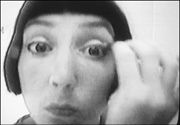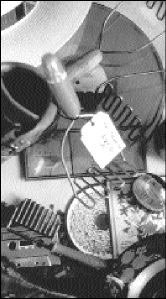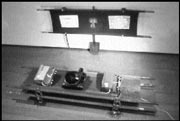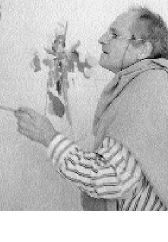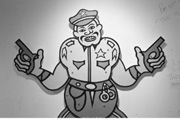Hello! Artists who connect with their audiences on more than just a visual level excite us. Installation artist Nicola Vruwink, on the heels of her first solo show at James Harris Gallery and after being selected for BAM’s Northwest Annual this summer, is sure to be moving and shaking again soon with her ultra-kitschy, politically charged works of mixed media. Her feminist slant is by no means groundbreaking, but Vruwink joins a national trend in contemporary art that has been referred to as “prolonged adolescence.”
Her work defies seriousness at every turn yet remains thought-provoking and conceptually in-your-face. It is work that must be experienced on more than one level, and Vruwink herself is part of the experience. Often featured in her own video work, she is a gadabout, not afraid to promote herself as an art celebrity. That’s what it takes, that’s what people want. Playful and intentionally naﶥ, the work merges humor with social critique, and, according to the entertainment-driven sensibilities of the new millennium, Vruwink dutifully presents it in appealing, girly-pink, and flower-adorned bundles.
And Vruwink is in tune with the idea that art’s all about spectacle right now, a pointed blurring of the lines that contain art in definable categories. As EMP pulls potential audiences away from every other art institution in town, lots of attention is being paid to what it is exactly, beyond all the Gehry glitz and shiny newness. The answer’s in the name: experience. Our attention spans aren’t long enough to endure the format that has served museums and galleries so well until now. Art merely hanging on walls is no longer enough. People crave spectacle, they want interactive consoles, virtual reality, and multimedia stations with all the visceral, visual, and tactile stimuli of the fast-paced entertainment world, all neatly packaged and user-friendly. The new Bellevue Art Museum is being constructed around “experientiality”—which isn’t even a real word, but just wait. It will be.
Goodbye! Fall finds Seattle’s art scene in an unprecedented state of agitation. Flux is the word that comes to mind as one surveys what has transpired in the last few months and what is to occur this season—all the new blood waiting tremulously and the old blood trying not to slam the door too hard on its way out. This season promises further entropy and an exciting, bumpy ride on through to the big 2001.
Whether they’re bailing out, storming out, or slipping quietly out, quite a number of the high rollers in the art game are leaving old posts for something new. The most prominent of these is Trevor Fairbrother, Seattle Art Museum’s deputy director and curator of modern art, who’s due to cast off from that mothership in December. In another departure, the Shoe Building is closed, marking the end of an era for the “Skid Road” gallery scene. Progressive galleries, co-ops, and nonprofits are cropping up—or asserting themselves more aggressively—all over town, almost everywhere except staid and expensive Pioneer Square. The tone of the First Thursday gallery walks is one of increasing stodginess as the commercial galleries remain, outnumbering the dwindling “indies.” The real estate squeeze is on and the little guys are being pushed off the beaten path. SOIL has moved up to Capitol Hill. CoCA is on the lookout for new digs. Sadly and ironically, in this boom time for Seattle, the visual arts are neglected.
